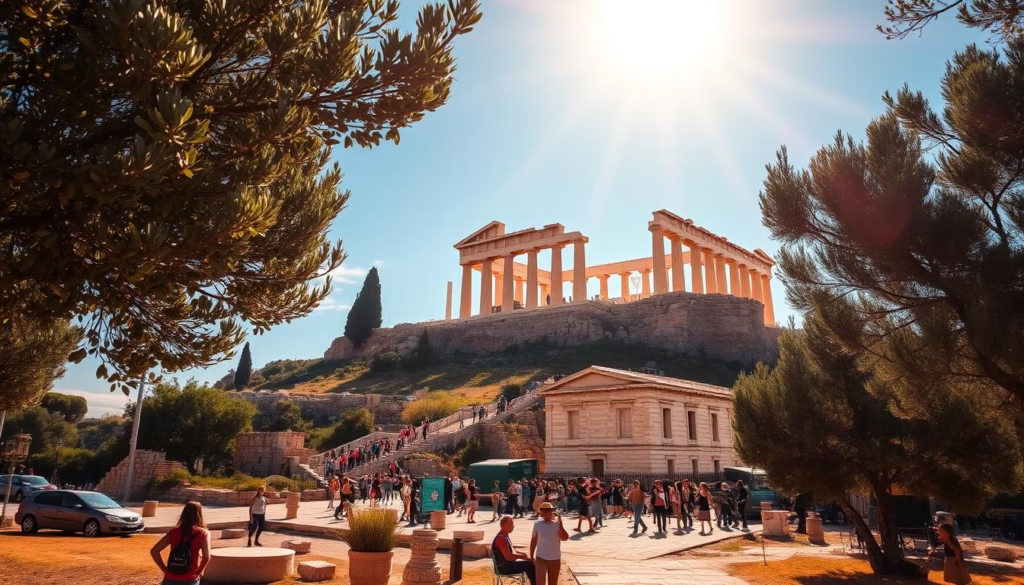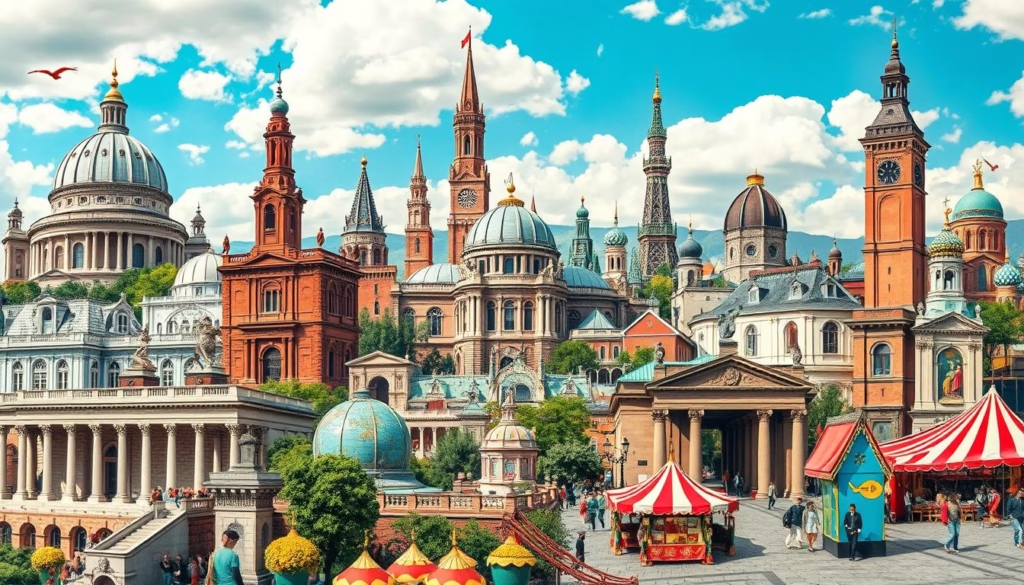Cultural Tourism: The Best Cities for Art and History Lovers
January 3, 2025 | by m33559844@gmail.com

Imagine walking through cities where every corner tells a story. Murals share tales, and festivals are full of life. Cultural tourism is more than visiting places; it’s diving into a community’s heart. It’s about understanding its history and marveling at its art.
Picture yourself in a city where potters and musicians fill the air with tradition. These experiences help us see who we are and connect with the world. This article will show you the top places for art and history lovers. From Greece’s ancient ruins to Colombia’s arts scene, these cities offer a journey through creativity and culture.
Key Takeaways
- Cultural tourism connects travelers to local traditions and rich histories.
- Exploring cities filled with artistic expression enhances personal enrichment.
- Many cultural destinations boast unique festivals and community-oriented experiences.
- Understanding cultural nuances can deepen our appreciation of a place.
- Historical sites offer invaluable insights into heritage and civilization.
If you’re ready to kickstart your travel journey with ease and exclusive savings, book your first trip now! Visit Trip.com using this special promotion link and register to reserve tickets, accommodation, and more. Don’t miss out on these incredible travel deals tailored for first-time travelers—start planning today!
Introduction to Cultural Tourism
Cultural tourism has become a key part of the travel world, drawing in millions worldwide. It lets travelers dive into a place’s cultural heritage, making their trip more meaningful. For example, Florida welcomes over 100 million visitors each year, with 65% of them taking part in cultural activities1.
This kind of tourism often leads to more spending and longer visits. It sets cultural tourists apart from others1.
To draw in cultural tourists, places need to offer real experiences. These should highlight the area’s history, art, and culture1. The United Nations sees cultural tourism as traveling to learn and experience a place’s culture2.
Groups working in cultural tourism must think about their goals, how they engage with visitors, their funding, and their impact on the community1.
Working together, Destination Marketing Organizations (DMOs) and cultural spots can boost cultural tourism1. Also, making cultural tourism more accessible is key, so more people can enjoy it2. As travel becomes more connected, cultural tourism’s importance keeps growing, shaping how we travel.
Mexico City: A Mosaic of Cultural Experiences
Mexico City is a cultural gem with a lively scene. It shows off its rich history and lively traditions. People from all over come to see its art and history.
Vibrant Museum Scene
The city has many museums, like the Palace of Fine Arts and Museo Soumaya. They show ancient and modern art. This shows Mexico City’s deep artistic roots. With over 1,400 old buildings, museums are part of the city’s cultural history3.
Annual Festivals and Local Traditions
Mexico City lights up with festivals every year. The Dia de Muertos is a big one, honoring the dead with altars and fun. It shows the city’s love for heritage and family4.
The city’s food, from street tacos to fancy restaurants, also shows its culture and traditions4.
Architectural Marvels
Mexico City’s buildings mix Aztec, Spanish, and modern styles. The Metropolitan Cathedral and Templo Mayor are key sites. They draw many visitors3.
Chapultepec Park is a big favorite. It’s huge, with museums and trails. It adds to the city’s cultural charm4.
Prague: The City of a Hundred Spires
Prague is famous for its beautiful buildings and deep history. It’s like an open-air museum. Visitors can see many architectural wonders, like the landmarks that make up its skyline.
The city has Gothic towers, Baroque churches, and Renaissance buildings. This mix of styles shows Prague’s lively culture.
Outdoor Museums and Architecture
Prague Castle is one of the biggest castle complexes worldwide. It has been important for over a thousand years5. The Charles Bridge, with its 30 statues, shows the city’s Gothic beauty6.
The Astronomical Clock in Old Town Square is the oldest working clock in the world. It draws many tourists every year6 and5. The Vltava River adds to the beauty, being a key trade route for centuries5.
Your Guide to Performing Arts
Prague is a hub for the performing arts, with many theaters and venues. The National Theatre is a top spot for opera, ballet, and drama7. Events like the Prague Spring International Music Festival highlight the city’s cultural dedication7.
With affordable prices and lots of local shows, art fans can dive into Prague’s essence.
Cape Town: A Cultural Melting Pot
Cape Town is a true melting pot of cultures and languages. Its festivals offer a special way for visitors to connect with its rich heritage. Events like the Kaapse Klopse and the International Festival of Public Art showcase local traditions and encourage community involvement.
These celebrations highlight Cape Town’s cultural diversity. They reflect the city’s history, shaped by indigenous Khoikhoi and San people, European settlers, and immigrants from Asia and Africa89.
Celebrating Multiculturalism through Festivals
Festivals in Cape Town boost the local arts scene. They are fueled by the creativity of local artists whose work is seen all over the city. The Cape Town Minstrel Carnival, for example, celebrates the area’s diverse identities, bringing people together from all walks of life.
These events create a lively atmosphere that keeps changing. Visitors can dive into the city’s cultural richness through performances, parades, and exhibitions. These experiences show the unity and diversity of the local community9.
Visual Arts and Local Artists
The visual arts in Cape Town are thriving, with local artists making waves globally. Places like the Zeitz Museum of Contemporary Art are major draws, featuring local and international art. Street art also adds to the city’s vibrant culture, telling stories of the community’s identity and social issues.
This artistic scene is open to all who want to see different viewpoints. Cape Town is known for its artistic energy and cultural richness810.
Buenos Aires: The Heartbeat of Arts
Buenos Aires is a vibrant city filled with culture. It has a rich arts scene that draws people in. The city is famous for tango, a dance full of rhythm and passion.
Theatrical and Musical Heritage
In Buenos Aires, the arts scene is alive with theater and music. The Teatro Colón is a world-famous opera house. About 70% of the people here love to watch and listen to different performances.
Street Art and Tango
The streets of Buenos Aires are full of street art. The Caminito neighborhood is a colorful example of this. It shows the influence of Italian immigrants on the city’s architecture.
Tango fills the alleys, attracting many fans. There are even places dedicated to Diego Maradona, the famous soccer player. Exploring these art forms gives you a true feel of Buenos Aires.
The San Telmo fair is a place to find unique crafts. The National Historical Museum tells stories of Argentina’s past. Cultural spots in Recoleta, like the Recoleta Cultural Center, attract millions of visitors.
Bookstores are popular, but museums are more in demand. This shows the city’s love for learning and culture.
Athens: The Cradle of Western Culture
Athens is known as the cradle of Western culture. It has a history spanning over 3,000 years, making it one of the world’s oldest cities11. The city is filled with ancient ruins that show its glorious past and deep cultural heritage. At the heart of this history is the Acropolis, home to the famous Parthenon.
The Parthenon was built in the 5th century BC. It is celebrated as a masterpiece of Ancient Greek architecture11.
Exploring Ancient Ruins and Museums
The Acropolis is more than just an archaeological site. It inspires and educates visitors. The museums around it showcase artifacts that tell Athens’ story from ancient times to today.
Today, Athens is a bustling city with over 3 million people11. Visitors can learn about the city’s cultural heritage through guided tours and interactive exhibits.
Contemporary Cultural Initiatives
Athens is not just about its history. It also has vibrant contemporary cultural initiatives. The Stavros Niarchos Foundation Cultural Center is a great example.
It combines modern architecture with cultural spaces for art, music, and public events. This shows Athens’ commitment to its history and modern culture12.

If you’re ready to kickstart your travel journey with ease and exclusive savings, book your first trip now! Visit Trip.com using this special promotion link and register to reserve tickets, accommodation, and more. Don’t miss out on these incredible travel deals tailored for first-time travelers—start planning today!
| Landmark | Year Established | Description |
|---|---|---|
| Acropolis | 5th century BC | Home to the Parthenon and a symbol of Ancient Greek civilization. |
| Parthenon | 447-432 BC | A temple dedicated to Athena, exemplifying ancient architectural mastery. |
| Stavros Niarchos Foundation Cultural Center | 2016 | Modern cultural facility supporting arts and education. |
Edinburgh: A Festival City
Edinburgh is famous for its lively arts scene and cultural festivals. The Edinburgh Festival Fringe is a major highlight, turning the city into a stage in August. In 2022, it sold 2.2 million tickets, with 39% going to locals13.
Visitors can enjoy a wide range of performances, from comedy to theater. It’s a place where art comes alive.
The Edinburgh Festival Fringe
The Fringe is a platform for both new and well-known talents. It boosts the local economy, with an impact of over £280 million a year. It showcases many art forms, drawing in both locals and tourists.
World-Class Museums and Galleries
Edinburgh’s museums and galleries add to its cultural appeal. The National Museum of Scotland on Chambers Street explores Scottish history and more. The city has seven of Scotland’s top attractions, drawing over 30 million visitors in 201714.
Places like the Real Mary King’s Close and the Royal Yacht Britannia offer a glimpse into Edinburgh’s past and royal connections. They are must-see spots for those interested in art and history.
Edinburgh’s mix of festivals and museums makes it a key spot for art lovers.
Cultural Tourism: Why It’s Growing in Popularity
Cultural tourism is on the rise, showing a growing interest in real travel experiences. People want to dive into local customs and traditions, learning about the world in a new way. The United Nations World Tourism Organization says cultural tourism makes up about 40 percent of all travel15.
In places like Florida, tourists who explore local culture help the economy a lot. They spend almost $1 billion each year15.
Benefits of Cultural Immersion
Getting to know different cultures helps us appreciate life more. A study found that cultural tourists stay longer and spend more than others. This helps businesses and strengthens community bonds15.
It also makes communities more inclusive and protects traditional ways of life15.
Connecting with Local Cultures
Places like Greater Fort Lauderdale attract over 130 million visitors each year. This boosts the local economy a lot15. Visitors enjoy museums, festivals, and art shows, supporting the creative scene.
Such tourism also brings in skilled workers, helping the area grow in the long run15. Programs like the U.S. National Park Service’s tribal tourism and UNESCO’s Creative Cities Network help keep cultural ties strong16.
Understanding Heritage Tourism
Heritage tourism is key in keeping historical sites alive. Places like the Stranahan House Museum are vital for the community. They help with development and upkeep.
While more tourists can cause problems like litter, good management can solve these issues16. The growth of cultural tourism shows a desire for deep, respectful experiences that connect us all.

Must-See Heritage Sites Around the World
Heritage sites are precious treasures that show the rich history and culture of humans. They attract millions of visitors every year. Places like Italy and Greece are famous for their historical landmarks that tell the stories of old civilizations.
These sites, with their ancient architecture and archaeological wonders, are key attractions for those interested in culture.
Iconic Locations in Italy
Italy is known for its famous heritage sites, showing a big part of European history. The Colosseum in Rome is a symbol of ancient Roman engineering and gladiatorial battles. The ruins of Pompeii, frozen in time by volcanic ash, give a glimpse into Roman life.
These sites and more make Italy a UNESCO World Heritage-rich nation, with over 55 locations officially recognized17.
Exploration of Historical Landmarks in Greece
Greece is also a treasure trove of historical landmarks. The Acropolis of Athens, with its Parthenon, represents ancient Greek civilization. Delphi is a reminder of the ancient world’s spiritual center.
UNESCO recognized Greece for its archaeological significance and lasting historical legacy. This attracts tourists who want to connect with their roots18. These sites tell stories that have shaped not just their countries, but the world.
Authentic Cultural Experiences to Seek
Traveling is more than seeing famous sights. It’s about making connections and learning about different cultures. By exploring local markets and trying local food, you can really get to know a place. These activities help you see the rich traditions and values of the area.
Cultural Tourism : Street Markets and Local Cuisine
Street markets are lively hubs of culture and community. They offer a chance to try foods that tell the story of the region. Enjoying local dishes makes your trip even better.
Visiting street markets can boost the local economy by 25%19. It also helps travelers connect with locals. Over 90% of travelers love these experiences, showing their value19.
Cultural Tourism : Festivals that Celebrate Local Traditions
Festivals give a peek into a community’s soul. They show off local customs and help preserve culture by up to 40%19. By joining in, travelers learn a lot about local life and values.
Many travelers (33%) seek local cultural experiences over traditional tours20. Festivals are key to understanding the places we visit.

If you’re ready to kickstart your travel journey with ease and exclusive savings, book your first trip now! Visit Trip.com using this special promotion link and register to reserve tickets, accommodation, and more. Don’t miss out on these incredible travel deals tailored for first-time travelers—start planning today!
The Future of Cultural Tourism
The future of cultural tourism is set to change a lot. It will focus more on being sustainable and involving local communities. This shift will make sure visitors enjoy local traditions without harming the environment. Experts predict that cultural tourism will grow a lot, reaching US$22,772.0 million by 203321.
Cultural Tourism : Tourism Development and Sustainability
As tourism grows, it’s important to do it sustainably. Places like Greece are showing how to mix cultural tourism with green practices. This approach can protect local heritage and the environment21.
Cultural tourism is a big job creator, with 300 to 350 million jobs worldwide21. Finding a balance between new ideas and preserving traditions is key.
Cultural Tourism : Impact of Globalization on Cultural Destinations
Globalization brings both chances and challenges for cultural tourism. It changes how places share their culture, making it important to keep traditions alive. New technologies help destinations stay true to their roots while attracting visitors with fresh experiences22.
The top five countries make up a big part of the cultural tourism market. They help mix local and global flavors, showing the need for global connection and cultural respect21.
Travel Tips for Art and History Lovers
Art and history fans can make their trips better by following some travel tips. Knowing when to go is key. It helps you dive into local events and traditions.
Cultural Tourism : Best Times to Visit Cultural Cities
Knowing the schedule of cultural events, festivals, and shows is important. Spring and early fall are great times to visit cities like Kyoto and Paris. You can enjoy local food, art, and music, giving you a real feel of the community.
Cultural Tourism : How to Engage with the Local Culture
Engaging with local culture is vital for a fulfilling trip. You can join workshops, go on guided tours, or visit street markets. This way, you can really connect with the place’s spirit. Talking to locals and joining in community activities gives you a deeper understanding of their way of life.
Using these tips makes your trip memorable and meaningful. It’s about respecting and appreciating the unique traditions of each place. Cultural tourism is about valuing different customs and shared experiences, not just famous spots23. Looking for local festivals and real interactions turns your visit into a journey that stays with you2425.
Conclusion
Cultural tourism is a great way for travelers to explore the heart of global communities. It lets them enjoy local festivals and try traditional foods. This way, they make real connections and learn to love cultural heritage.
With cultural tourism making up about 39% of all travel, it’s big business. It helps local economies and keeps traditions alive. It also protects important historical sites2627.
More and more people want real experiences when they travel. This means cultural tourism is getting more popular. It’s important to do it in a way that respects local communities and the environment2826.
By supporting local artisans and joining in on events, we help keep cultural stories alive. This is important as the world changes around us2826.
Cultural Travel: Top Destinations for Authentic Experiences . In a world where cultures are mixing more, cultural tourism is key. It lets us share and learn from each other’s stories. This makes our world richer and helps us understand different cultures better2827.
FAQ : Cultural Tourism
What is cultural tourism?
Cultural tourism lets you dive into the arts, heritage, and events of different places. It offers real experiences and a deep connection to local traditions and history.
Why is cultural tourism becoming more popular?
As the world connects more, people want to know their cultural roots and explore new traditions. They seek authentic travel that helps them understand and value local cultures.
What are some key cities known for cultural tourism?
Cities like Mexico City, Prague, Cape Town, Buenos Aires, Athens, and Edinburgh are famous for their rich cultural scenes. They have historical landmarks and diverse traditions that draw art and history lovers.
How can travelers immerse themselves in cultural experiences?
To dive into cultural experiences, travelers can join local festivals, visit heritage sites, explore street markets, and try local foods. These activities help build real connections with communities and deepen appreciation for cultural diversity.
What role do heritage sites play in cultural tourism?
Heritage sites are key attractions in cultural tourism. They let visitors see and understand human history’s big stories. Places like the Colosseum in Italy and the Acropolis in Greece offer insights into ancient cultures and heritage.
What is the future of cultural tourism?
The future of cultural tourism focuses on sustainable growth. It emphasizes caring for the environment and working with local communities. It’s important to balance modern changes with keeping cultural identities unique.
How can I make the most of my visit to cultural cities?
To get the most out of cultural cities, know the best times to visit and seek out local interactions. Joining in cultural events and workshops helps you understand and connect with the place.
RELATED POSTS
View all



